Welcome
to the McGill Bird Observatory weekly report.
Click here for a complete listing of our archives.
Comments or
questions are welcome at "mbo AT migrationresearch.org".
|
PICTURE
OF THE WEEK: |
|
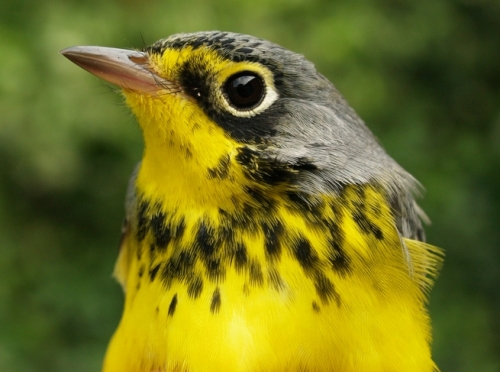
One of the starts of the first week of our sixth fall season was this gorgeous
after-hatch-year male Canada Warbler.
(Photo by Simon Duval)

|
MBO
gratefully acknowledges the fundraising efforts of CCFA (Centre de Conservation de la Faune Ailée) in support of MBO - drop in at the store or click on the logo at left to visit the website for details on bird posters for sale with proceeds benefiting MBO.
|
|
|
|
THIS WEEK |
THIS FALL |
2010 TOTAL |
SITE TOTAL |
|
# birds (and species) banded |
250 (37) |
250 (37) |
1125 (65) |
24634 (105) |
|
# birds (and species) repeat |
35 (16) |
35 (16) |
249 (33) |
4590 (66) |
|
# birds (and species) return |
6 (5) |
6 (5) |
138 (28) |
758 (37) |
|
# species observed |
71 |
71 |
142 |
201 |
|
# net hours |
468.0 |
468.0 |
4027.4 |
43934.6 |
|
# birds banded / 100 net hours |
53.4 |
53.4 |
28.0 |
56.1 |
|
|
Note: table does not include nocturnal banding (owls) |
|
Bander-in-charge: Simon Duval
Assistants: Christine Barrie, Eve Bélisle, Jean Demers, Richard Dupuis, Gay Gruner, Marie-Anne Hudson, Barbara MacDuff, Chris Murphy, Clémence Soulard, Patricia Stotland
Notes: Every year it seems like the start of our fall migration monitoring program is upon us before we've had a chance to fully enjoy summer - but with this being our sixth full year of operation, we know that a variety of species are already on the move this early. In fact, analysis of our first five years of data reveals that on average, 8 species peak in numbers during the first week of August: Warbling Vireo, House Wren, Veery, Yellow Warbler, Song Sparrow, Rose-breasted Grosbeak, Indigo Bunting, and Baltimore Oriole.
This year the fall season kicked off with a bang - a record-high 250 birds banded in the first week, including 79 individuals of 23 species on August 2, both numbers the highest for any day in August since 2005. Away from the nets, the 71 species observed was right on our five-year average for this week, and thanks to sharp-eared census observers, it included the first MBO record of Red-bellied Woodpecker, which became species #201 on the site checklist.
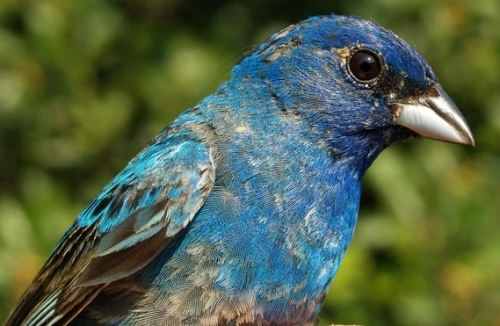
Fall migration always brings us a variety of interesting opportunities to observe birds in active molt. Although Indigo Bunting is one of the species that peaks in this first week of the season, we regularly see them in small numbers as late as October, and it's rare we get more than a couple of them that look similar! On the other hand, we won't see most of our Swainson's Thrushes until past the midpoint of our season, but the one photographed below continues our trend of catching a small number of molt migrants in early August - essentially adults that have headed south from their breeding grounds and have chosen to replace their flight feathers at MBO instead.
(Photos by Simon Duval)
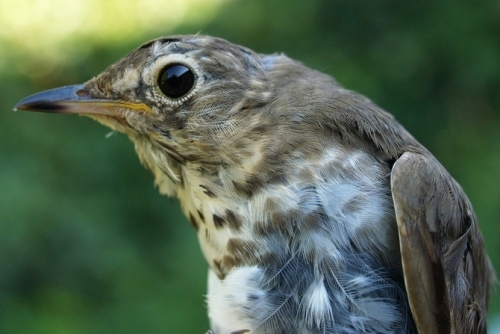
|
August is always a busy time for people, and we are particularly appreciative of the volunteers who are able to fit MBO into their summer schedules. Special thanks this week to Malcolm Johnson for doing a great job (as usual) of preparing our net lanes for the season, and to Jean Demers and Clémence Soulard for helping put up the nets, a task that is made infinitely easier with a couple of extra pairs of hands.
|
This week’s top 10
[last year's rank for this week in brackets]
|
# individuals banded |
mean # individuals observed daily |
|
1. Song Sparrow (34) [1] |
1. Cedar Waxwing (24.6)
[4] |
|
2. Yellow Warbler (29) [1] |
2. American Robin (21.7) [2] |
|
3. American Redstart (22)
[4] |
3. Black-capped Chickadee (19.3)
[2] |
|
4. American Robin (17)
[7] |
4. Song Sparrow (13.9)
[5] |
|
5. Cedar Waxwing (15) [6] |
5. Common Grackle (13.1)
[1] |
|
6. Rose-breasted Grosbeak (13) [3] |
6. American Crow (11.4) [-] |
|
6. Black-capped Chickadee (13)
[-] |
7. American Goldfinch (8.9)
[6] |
|
8. Red-eyed Vireo (12) [9] |
8. Red-winged Blackbird (8.1) [9] |
|
9. Common Yellowthroat (11)
[-] |
9. Indigo Bunting (6.3) [-] |
|
10. Tennessee Warbler (10) [-] |
10. Yellow Warbler (6.1)
[8] |
|
With five years of history to look back on, it is becoming increasingly interesting to compare results from the present year with what we might expect based on prevoius seasons. In terms of the birds banded, Song Sparrow has now been the champion for the first week of fall every year except 2008, when it swapped positions with Yellow Warbler, traditionally the second-most commonly banded species. So, the top of this week's list is hardly a surprise! However, American Redstart in third place is noteworthy, since for the past four years our season total for this species has consistently increased, and they have begun to arrive earlier with each passing year; this week's count breaks last year's week 1 record by another 7 individuals. Most of the others in the top ten are regular species at this time of year, with all except Red-eyed Vireo and Common Yellowthroat having appeared on the list in at least three previous years.
The list of species observed shows even more similarity to last year's results. The top five species have simply been shuffled around, with Cedar Waxwing unusually common this year (ranked between 4 and 8 in other years, and with average daily counts ranging between 6 and 18 individuals). American Crow is back on the list, having missed the top ten for this week only in 2009. The only surprise entry on the list this year is Indigo Bunting - although it peaks in the first week of August, numbers have never before been high enough for it to crack the top ten, with the previous record high daily average for a week being 4.6 individuals.
|
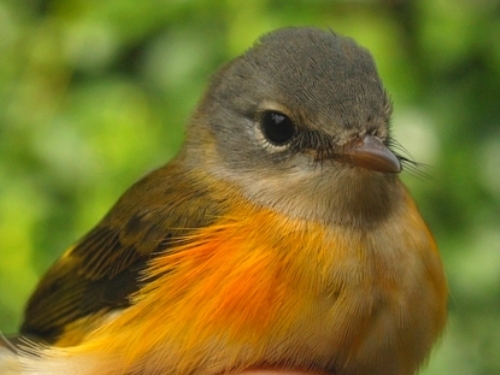
Beginning last fall we started to record the "armpit" colour of American Redstarts using a standard colour chart, in an effort to assess whether it can be reliably used as an aid to sex determination. This individual has the brightest orange of any we've seen.
(Photo by
Simon Duval)
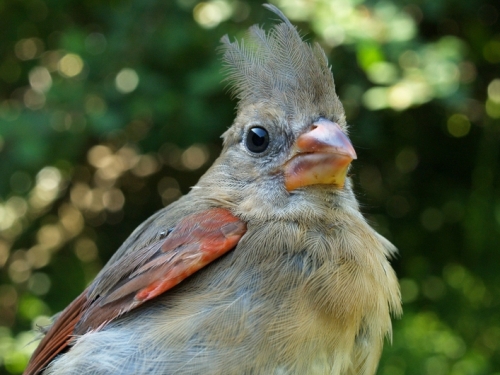
We often band a few Northern Cardinals in the early part of the season, most commonly the offspring of the local pairs.
(Photo by Simon Duval)
|






